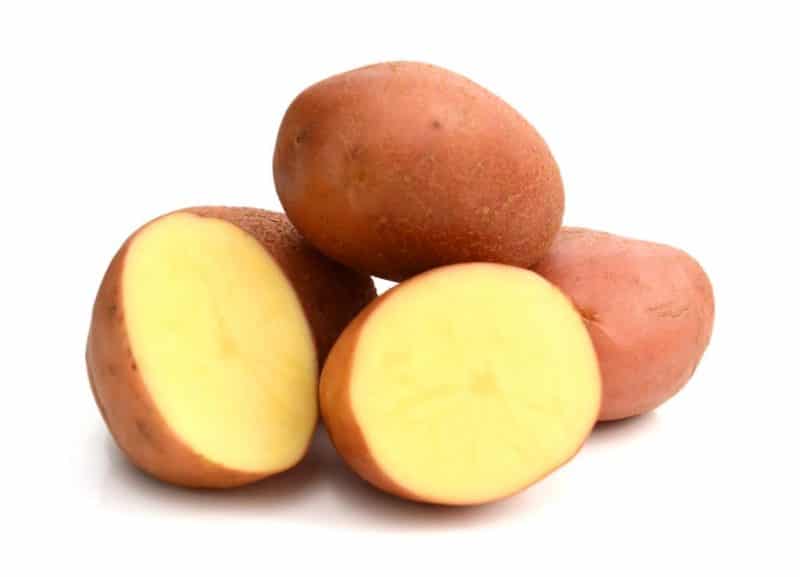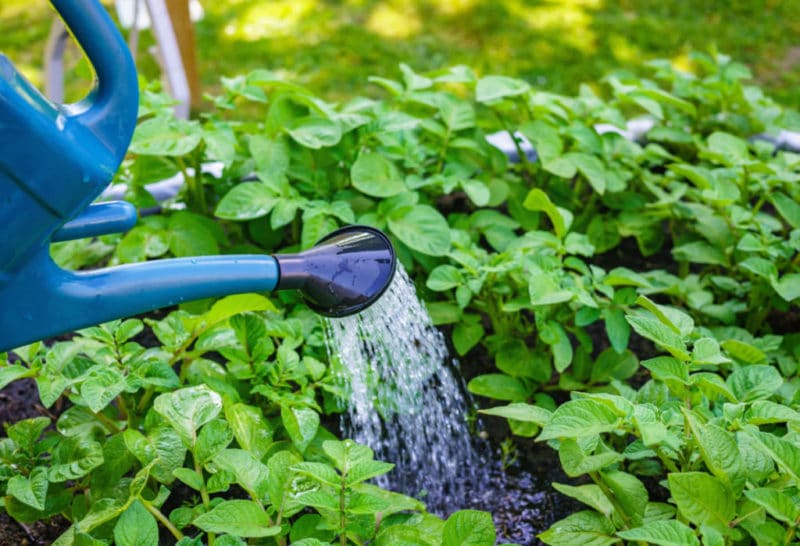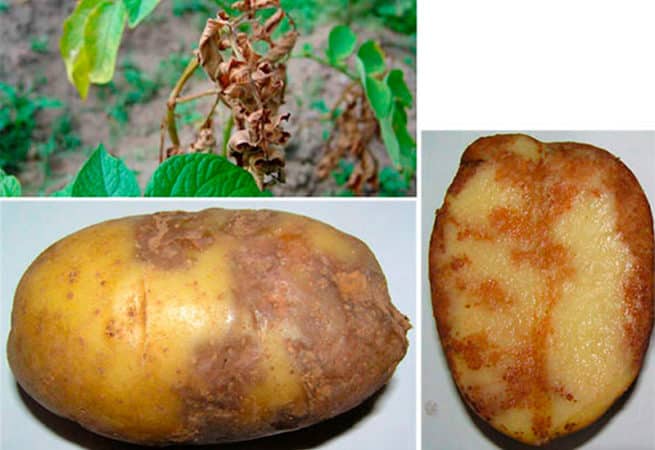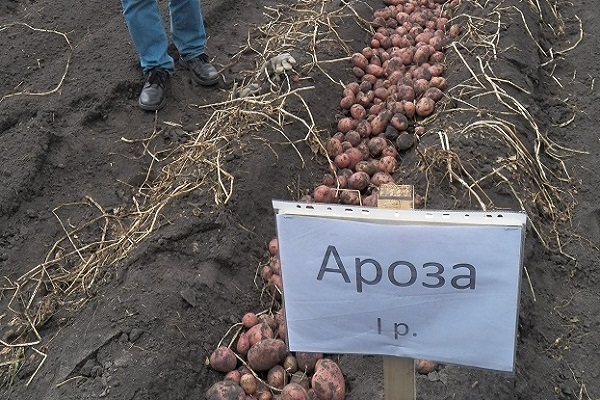Arosa potato variety, capable of growing even in the most difficult climatic conditions
Arosa is a relatively new potato variety. Farmers highly appreciate it for its unpretentiousness, rapid adaptation to weather conditions, and resistance to many diseases characteristic of potatoes. In the article you will find a description of the Arosa potato variety, photos and recommendations for growing.
Potato Arosa: variety description
The Arosa variety was developed thanks to the work of German breeders from the company UniplantaSaatzucht. This variety appeared on the market in early 2009.
The photo shows Arosa potatoes.

Chemical composition, trace elements and vitamins
Potatoes contain fiber, glucose, sucrose, mineral salts, ascorbic acid, B vitamins, carotenoids, as well as proteins and carbohydrates. The starch content in the Arosa variety is up to 14.3%.
Potatoes belong to culinary type B. The tubers are suitable for baking, frying, stuffing, and use in salads.
Ripening period
The ripening period is about 60 days from the emergence of seedlings to the harvesting of potatoes. Young tubers can be harvested on the 45-50th day of the growing season.
Productivity
If all the rules for planting and subsequent care are followed, up to 50 tons of root crops can be collected from 1 hectare. On average, each bush produces up to 15 tubers.
Disease resistance
The variety is characterized by resistance to nematodes, potato canker, mosaic, viral infections, fusarium, but is less resistant to late blight, silver and black scab. However, with all preventive measures, these diseases can be avoided.
Characteristics of tubers, description of appearance
Tubers are oval, oblong, weighing 80-150 g. The peel is thin and has a red tint. There are small eyes on the surface of the tuber.
The pulp is bright yellow and does not darken during processing.
Taste quality is rated by gardeners and cooks at 4.5 points on a five-point scale.
Suitable regions and climate requirements
Designed for cultivation in regions with temperate climates. In the Russian climate maximum yield can be achieved in the following regions: Volga, North Caucasus and West Siberian.
Advantages and disadvantages

The advantages of the Arosa variety include:
- high yield rates;
- high resistance to drought - according to the breeders, the variety can adapt to different weather conditions, which allows it to be grown not only in temperate climates, but also in the southern regions;
- excellent presentation;
- the possibility of transportation without loss of appearance and quality (sustainability rate is up to 95%), which makes the crop profitable for commercial cultivation;
- versatility of use;
- high taste qualities;
- resistance to many bacterial and viral diseases.
The variety has much fewer disadvantages. The main one is instability to late blight and scab. Also, when growing Arosa, you need to carefully use mineral fertilizers so as not to reduce the yield.
Differences from other varieties
Main differences:
- the variety is not afraid of viral diseases;
- possibility of cultivation without additional irrigation.
Features of planting and growing
It is recommended to choose for potatoes sunny and ventilated areas located on a hill.
Agronomists also advise arranging beds from north to south.
Soil requirements
The variety is unpretentious to the composition of the soil, as it quickly adapts to growing conditions. But to get a good harvest, when preparing the site in the fall, the following is added per square meter of soil:
- 1 tbsp. l. superphosphate;
- 200 g of ash;
- 10 kg of compost.
Before directly planting the tubers, the soil is loosened and leveled with a rake to saturate it with oxygen.
If planting is carried out in areas with peat soil, it is advisable to add a little humus and river sand to the soil.
Dates, scheme and rules of planting
When choosing a planting time, they are guided by the soil temperature - it should be warmed up to at least +10 °C.
Approximate dates:
- for the southern regions - early May;
- for the central part of the country - mid or late May.
To get a good harvest, the gardener needs to organize a large area for feeding the crop. The tubers are buried to a depth of 8-10 cm in the soil, leaving a distance between holes of at least 30 cm, and between rows - at least 0.7 m. After planting, Arosa seed potatoes are sprinkled with a layer of earth up to 8 cm thick.
Advice. If the tubers have sprouted, they should be planted as carefully as possible so as not to break the sprouts.
Features of cultivation
Preparing planting material will make the plants stronger and increase productivity. For planting, medium-sized potatoes weighing about 70 g without dents or other signs of damage are selected..
30-40 days before landings they are taken out for germination to speed up germination. To do this, planting material is placed in a warm (up to +15 ° C) and sunny place.
14 days before planting, the tubers are treated with Alirin-B or Gamair, which will serve as an excellent means of prevention against scab.
Watering

During the growing season, potatoes should be watered at least three times: the first time - 30 days after planting, then - during the appearance of buds and after flowering.
In dry and hot weather, the amount of watering is increased. For each bush - at least 3 liters of warm water, and watering is carried out either in the evening or early in the morning, when there is no sun.
Top dressing
Arosa needs to be fed in several stages. It is necessary to strictly observe all proportions of nutrients. If there is an excess of them, the plant may get sick and die.
Stages:
- During the period of buds and flowering, fertilizers containing phosphorus and potassium are added to the soil. To prepare your own fertilizers, mix 15 g of superphosphate and potassium sulfate in 10 liters of water. Consumption per square meter of bed is 1 liter of mixture.
- Three weeks before harvest, the plantings are watered with complex mineral-organic fertilizer. To prepare it, 25 g of superphosphate and 250 ml of manure are mixed in 10 liters of water.
The application of the last complex fertilizer is very important, since with it the tubers will receive the necessary nutrients for storage.
Weeding and hilling
After watering and rain, it is recommended to loosen the soil. Thanks to this, it will be saturated with oxygen. Weeding will also help get rid of weeds in potato beds.
Hilling is an important event, thanks to which the root system of the crop develops faster and more tubers are formed.
During the entire growing season, plants are hilled three times:
- when the shoots grow to 10 cm in height;
- during tying buds;
- during the flowering period, when the height of the shoots is about 20 cm.
If the shoots begin to stretch out and the bushes are falling apart, it is worth carrying out unscheduled work. The main thing is to act carefully to avoid damaging the roots.
Disease and pest control

Signs potato diseases and methods of dealing with them are described in the table.
|
Disease |
Signs |
Treatment options |
| Silver scab | Brown spots appear on the tubers, which then turn silver. The peel wrinkles. | After harvesting, it is worth treating the potatoes with Maxim. For preventive purposes, before planting, planting material is treated with Quadris. |
| Late blight | Brown spots form on the leaves of the plant, then they become covered with a gray coating. | When the first signs appear, the crop is treated with Fitosporin or Ridomil. |
| Black scab | Dark spots form on the potatoes, and the tubers begin to rot. | Plants are sprayed with Maxim and treated with Titus before planting. |
The following actions are recommended as prevention:
- compliance with crop rotation;
- planting high-quality seed material;
- timely harvest of potatoes.
The pests that most often attack Arosa potatoes are the Colorado potato beetle and mole cricket. To get rid of insects, use “Bikola” and “Kinmiks”.
Difficulties in growing
The main difficulty is incorrect calculation of fertilizer consumption. To avoid this, it is recommended to limit the use of nitrogen-containing additives by adding more organic fertilizers when preparing the site for planting in the fall.
Harvest and storage

The potato harvest is harvested in the 2nd-3rd decade of July. The maturity of root crops will be indicated by fading tops. A few days before harvesting the potatoes, they are mowed.This reduces the likelihood of late blight and also helps root crops gain maximum nutrients.
Storage features and shelf life
One of the advantages of the variety is its long shelf life. To preserve root vegetables, they are dried and then placed in boxes, which should have small holes for air access.
In the first 10-14 days of storage, the temperature should be about +18°C, after which it is reduced to +2°C; humidity level – 80%.
Advice. The potatoes are sorted out periodically, which will allow timely removal of tubers that have already begun to deteriorate.
Advice from experienced gardeners
Since Arosa is an unpretentious variety, experienced gardeners advise following the basic rules for growing it:
- cultivate the land in a timely manner;
- apply fertilizers, water, loosen the soil after each watering or rain;
- observe crop rotation: plant potatoes after cucumbers, herbs, beets.
Reviews of the Arosa potato variety
Andrey, 40 years old, Volgograd: “Among the advantages of Arosa potatoes, I highlight the simplest possible care and high yield. I have been growing this variety for sale for more than 4 years. Unlike others, Arosa is not afraid of viral diseases and does not require irrigation, which significantly reduces labor costs for growing potatoes.”
Olga, 60 years old, Orel: “A neighbor recommended the Arosa variety. A very easy variety to care for, from each square meter I collected at least 3 kg of tubers of the same shape. I created a storage space in the basement - the potatoes lasted all winter and did not spoil.”
Conclusion
Arosa is a relatively new, productive, disease-resistant variety. It does not require care, the tubers are neat and even. Tolerates long-term storage well.Apply nitrogen-containing fertilizers moderately, follow agricultural practices and enjoy an excellent harvest!